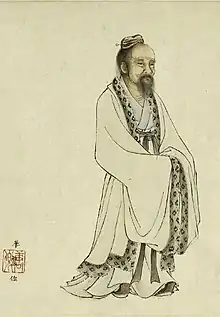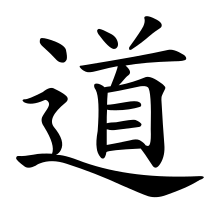Zhuangzi (莊子) Zhuang Zhou (莊周) | |
|---|---|
 | |
| Born | c. 369 BC |
| Died | c. 286 BC (aged c. 82 – 83) |
| Notable work | Zhuangzi |
| Era | Ancient philosophy |
| Region | Eastern philosophy |
| School | |
| Zhuangzi | |||||||||||||||||||||||||||||||||||||||||||||
|---|---|---|---|---|---|---|---|---|---|---|---|---|---|---|---|---|---|---|---|---|---|---|---|---|---|---|---|---|---|---|---|---|---|---|---|---|---|---|---|---|---|---|---|---|---|
.svg.png.webp) | |||||||||||||||||||||||||||||||||||||||||||||
| Traditional Chinese | 莊子 | ||||||||||||||||||||||||||||||||||||||||||||
| Simplified Chinese | 庄子 | ||||||||||||||||||||||||||||||||||||||||||||
| Hanyu Pinyin | Zhuāngzǐ | ||||||||||||||||||||||||||||||||||||||||||||
| Literal meaning | "Master Zhuang" | ||||||||||||||||||||||||||||||||||||||||||||
| |||||||||||||||||||||||||||||||||||||||||||||
| Zhuang Zhou | |||||||||||||||||||||||||||||||||||||||||||||
| Traditional Chinese | 莊周 | ||||||||||||||||||||||||||||||||||||||||||||
| Simplified Chinese | 庄周 | ||||||||||||||||||||||||||||||||||||||||||||
| Hanyu Pinyin | Zhuāng Zhōu | ||||||||||||||||||||||||||||||||||||||||||||
| |||||||||||||||||||||||||||||||||||||||||||||
| Part of a series on |
| Taoism |
|---|
 |
Zhuang Zhou (/dʒuˈɑːŋ ˈdʒoʊ/),[1] commonly known as Zhuangzi (/ˈdʒwɑːŋˈdzʌ/;[2] Chinese: 莊子; literally "Master Zhuang"; also rendered in the Wade–Giles romanization as Chuang Tzu),[lower-alpha 1] was an influential Chinese philosopher who lived around the 4th century BCE during the Warring States period, a period of great development in Chinese philosophy, the Hundred Schools of Thought. He is credited with writing—in part or in whole—a work known by his name, the Zhuangzi, which is one of the foundational texts of Taoism.
Life
The only account of the life of Zhuangzi is a brief sketch in chapter 63 of Sima Qian's Records of the Grand Historian,[3] and most of the information it contains seems to have simply been drawn from anecdotes in the Zhuangzi itself.[4] In Sima's biography, he is described as a minor official from the town of Meng (in modern Anhui) in the state of Song, living in the time of King Hui of Liang and King Xuan of Qi (late fourth century BC).[5] Sima Qian writes that Zhuangzi was especially influenced by Laozi, and that he turned down a job offer from King Wei of Chu, because he valued his personal freedom.[6]
The validity of his existence has been questioned by Russell Kirkland, who asserts that "there is no reliable historical data at all" for Zhuang Zhou, and that most of the available information on the Zhuangzi comes from its third-century commentator, Guo Xiang.[7]
Writings
Zhuangzi is traditionally credited as the author of at least part of the work bearing his name, the Zhuangzi.[8] This work, in its current shape consisting of 33 chapters, is traditionally divided into three parts: the first, known as the "Inner Chapters", consists of the first seven chapters; the second, known as the "Outer Chapters", consist of the next 15 chapters; the last, known as the "Mixed Chapters", consist of the remaining 11 chapters. The meaning of these three names is disputed: according to Guo Xiang, the "Inner Chapters" were written by Zhuangzi, the "Outer Chapters" written by his disciples, and the "Mixed Chapters" by other hands; the other interpretation is that the names refer to the origin of the titles of the chapters—the "Inner Chapters" take their titles from phrases inside the chapter, the "Outer Chapters" from the opening words of the chapters, and the "Mixed Chapters" from a mixture of these two sources.[9]
Further study of the text does not provide a clear choice between these alternatives. On the one side, as Martin Palmer points out in the introduction to his translation, two of the three chapters Sima Qian cited in his biography of Zhuangzi, come from the "Outer Chapters" and the third from the "Mixed Chapters". "Neither of these are allowed as authentic Chuang Tzu chapters by certain purists, yet they breathe the very spirit of Chuang Tzu just as much as, for example, the famous 'butterfly passage' of chapter 2."[10]
On the other hand, chapter 33 has been often considered as intrusive, being a survey of the major movements during the "Hundred Schools of Thought" with an emphasis on the philosophy of Hui Shi. Further, A.C. Graham and other critics have subjected the text to a stylistic analysis and identified four strains of thought in the book: a) the ideas of Zhuangzi or his disciples; b) a "primitivist" strain of thinking similar to Laozi in chapters 8-10 and the first half of chapter 11; c) a strain very strongly represented in chapters 28-31 which is attributed to the philosophy of Yang Zhu; and d) a fourth strain which may be related to the philosophical school of Huang-Lao.[11] In this spirit, Martin Palmer wrote that "trying to read Chuang Tzu sequentially is a mistake. The text is a collection, not a developing argument."[12]
Zhuangzi was renowned for his brilliant wordplay and use of parables to convey messages. His critiques of Confucian society and historical figures are humorous and at times ironic.
See also
Notes
- ↑ Other romanizations include Zhuang Tze, Chuang Tsu, Chuang-tzu, Chouang-Dsi, Chuang Tse, and Chuangtze.
Citations
- ↑ "Zhou". Random House Webster's Unabridged Dictionary.
- ↑ "Chuang-tzu". Random House Webster's Unabridged Dictionary.
- ↑ "Daoism Series 23: 荘子 Zhuang Zi". Purple Cloud. 2020-08-30. Retrieved 2020-11-24.
- ↑ Mair (1994), p. xxxi-xxxiii.
- ↑ Ziporyn (2009), p. vii.
- ↑ Horne (1917), pp. 397–398.
- ↑ Kirkland (2004), pp. 33–34.
- ↑ Klein (2010), pp. 306–309.
- ↑ Roth (1993), pp. 56–57.
- ↑ Palmer (1996), p. xix.
- ↑ Schwartz (1985), p. 216.
- ↑ Palmer (1996), p. x.
References
- Ames, Roger T. (1991), 'The Mencian Concept of Ren Xing: Does it Mean Human Nature?' in Chinese Texts and Philosophical Contexts, ed. Henry Rosemont, Jr. LaSalle, Ill.: Open Court Press.
- Ames, Roger T. (1998) ed. Wandering at Ease in the Zhuangzi. Albany: State University of New York Press.
- Bruya, Brian (translator). (2019). Zhuangzi: The Way of Nature. Princeton: Princeton University Press. ISBN 9780691179742.
- Chan, Wing-Tsit (1963). A Source Book In Chinese Philosophy. USA: Princeton University Press. ISBN 0-691-01964-9.
- Chang, Chung-yuan (1963). Creativity and Taoism: A Study of Chinese Philosophy, Art, and Poetry. New York: Julian Press.
- Graham A.C, Chuang-Tzû, the seven inner chapters, Allen & Unwin, London, 1981
- Chuang-tzu: The Inner Chapters and other Writings from the Book of Chuang-tzu (London: Unwin Paperbacks, 1986)
- Creel, Herrlee G. (1982). What is Taoism? : and other studies in Chinese cultural history. Chicago: University of Chicago Press. ISBN 0-226-12047-3.
- Hansen, Chad (2003). "The Relatively Happy Fish," Asian Philosophy 13:145-164.
- Herbjørnsrud, Dag (2018). "A Sea for Fish on Dry Land," the blog of the Journal of History of Ideas.
- Horne, Charles F., ed. (1917). The Sacred Books and Early Literature of the East, Volume XII: Medieval China. New York: Parke.
- Kirkland, Russell (2004). Taoism: The Enduring Tradition. New York: Routledge. ISBN 978-0-415-26321-4.
- Klein, Esther (2010). "Were there "Inner Chapters" in the Warring States? A New Examination of Evidence about the Zhuangzi". T'oung Pao. Leiden: Brill. 96 (4/5): 299–369. doi:10.1163/156853210X546509. JSTOR 41354706.
- Mair, Victor H. (1994). Wandering on the Way: Early Taoist Tales and Parables of Chuang Tzu. New York: Bantam Books. ISBN 0-553-37406-0. (Google Books)
- Merton, Thomas. (1969). The Way of Chuang Tzu. New York: New Directions.
- Palmer, Martin (1996). The Book of Chuang Tzu. Penguin. ISBN 978-0-14-019488-3.
- Roth, H. D. (1993). "Chuang tzu 莊子". In Loewe, Michael (ed.). Early Chinese Texts: A Bibliographical Guide. Berkeley: Society for the Study of Early China; Institute of East Asian Studies, University of California Berkeley. pp. 56–66. ISBN 1-55729-043-1.
- Schwartz, Benjamin J. (1985). The World of Thought in Ancient China. Cambridge: Belknap Press. ISBN 978-0-674-96191-3.
- Shen, Tsing-song Vincent (2015). "Evolutionism through Chinese Eyes: Yan Fu, Ma Junwu and their Translations of Darwinian Evolutionism". ASIANetwork Exchange. 22 (1): 49–60. doi:10.16995/ane.135. ISSN 1943-9946. OCLC 8091685198.
- Waltham, Clae (editor). (1971). Chuang Tzu: Genius of the Absurd. New York: Ace Books.
- Watson, Burton (1962). Early Chinese Literature. New York: Columbia University Press. ISBN 9780231086714.
- The complete work of Chuang Tzu, Columbia University Press, 1968
- Watts, Alan with Huan, Al Chung-liang (1975). Tao: The Watercourse Way. New York: Pantheon Books. ISBN 0-394-73311-8.
{{cite book}}: CS1 maint: multiple names: authors list (link) - Ziporyn, Brook (2009). Zhuangzi: The Essential Writings with Selections from Traditional Commentaries Hackett Classics Series. Hackett Publishing. ISBN 978-1-60384-435-2.
External links
- Zhuangzi Bilingual Chinese-English version (James Legge's translation) - Chinese Text Project
- The Zhuangzi "Being Boundless", Complete translation of Zhuangzi by Nina Correa
- Chuang Tzu at Taoism.net, Chuang Tzu's Stories and Teachings - translations by Derek Lin
- Zhuangzi, The Internet Encyclopedia of Philosophy
- Zhuangzi, Stanford Encyclopedia of Philosophy
- Selection from The Zhuangzi, translated by Patricia Ebrey
- Chuang-tzu at Taopage.org
- Zhuang Zi, chapter 1
- Zhuang Zi, chapter 2
- James Legge Complete Translation In English The Legge translation of the complete Chuang Tzu (Zhuangzi) updated
- Works by Zhuang Zhou at LibriVox (public domain audiobooks)
